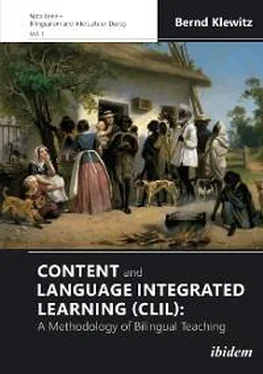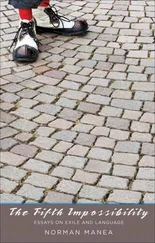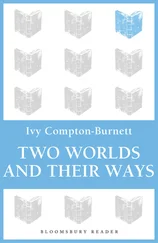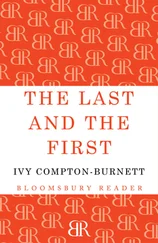1 ...6 7 8 10 11 12 ...15
2.5 The Input and Output Hypotheses
In conclusion, nativists—as exemplified by Chomsky and Meisel—tend to overestimate the challenges language learners have to face and underestimate the resources available to them. A child or adolescent does not represent a tabula rasa but they are able to lean on their own language development and can use their previous knowledge to perceive meaningful structures and extract helpful rules from further input. As a consequence for changes in teaching strategies and in the transition from young infants to older children, language learning appeared to be more convincing as a cognitive operation and replaced the assumption of a UG—even in its minimalist version or sole reliance on recursion—by a stronger focus on cognitive and mental solving capacities. In their theory of practice (cf. Coyle: 45) language instructors and linguistic researchers became convinced that, with growing age, conscious learning and language awareness would be more effective for developing grammar competence and lexical knowledge—always with a view to bridging the gap between competence and performance, as epitomized in the above-mentioned TOT and the Zone of Proximal Development.
This conviction and trend initiated a number of turnsin (foreign) language learning and teaching encapsulating shiftsfrom a previous focus on grammar to Task-Based Teaching and Learning (TBLT) and the growing importance of content. The ensuing transitionsstarted with tendencies of learner-centered approaches and cooperative (group) working phases, a change in the instructor’s role from “ sage on the stage ” to “ guide on the side ” and once again back to Direct Instruction in the version of explicit teacher influence and control and as opposed to exploratory models of inquiry-based learning. The two main sources for the “revival” of Direct Instruction—apart from much earlier versions in the 1960s—turned out to be DISTARand John Hattie’s meta-analyses recommending this teaching strategy. The “ Direct Instruction System for Teaching Arithmetic and Writing ” (DISTAR) and the “ Project Follow Through ” (1968-1977) was a “ cooperation between policy makers and educational practitioners ” (De Florio 2016: 99) and proved most effective for teaching academic skills and providing positive outcomes for children like empowerment, self-esteem and a feeling of achievement. It was, however, criticized for limiting creativity due to its strict and scripted procedures. Hattie’s encouragement of Direct Instruction (as interactive whole-class teaching), not to be confused with traditional teacher-centered instruction (the chalk-and-talk version of “ Frontalunterricht ” 6), was based on synthesized research of 304 studies with over 42,000 students showing a major effect size (d=0.59) and significantly larger than any other curriculum Hattie studied.
The UG theory had suggested that the nativist/innate language capacity (aka Meisel’s LMC; see above) of a child would be—more or less automatically—awakened by L1 contact and that L2 acquisition would follow the same mechanism. The fact, however, that under “normal” conditions L2 learning does not result in native-like competence and performance indicates that a direct and effortless access to the respective UG properties cannot be substantiated. Thus, and in another renunciation of behaviorism, the nativist position, namely Chomsky’s innate language theory, seems to have been superseded by cognitive approachesand even more recently by learning theories based on constructivism and findings of neuro-science. Common to these shifts in the theory of practice is that they do not take a language-specific mental module for granted (like in the UG and its minimalist version). They rather assume that language acquisition and learning 7are creative processes and occur in processing information in multiple ways.
In a succession of consecutive steps to explain the relationship between language acquisition and learning, Krashen’s monitor hypothesis (1977) can be regarded as an important starting point and building block in assigning the learning system the role of monitoring or controlling utterances, whereas the acquisition system would act as the initiator of language production. His further theoretical assumptions, namely acquisition-learning , natural order , input , affective filter and reading hypotheses , were instrumental in discovering stages of language development referring, for instance, to basic grammar domains like English negations or German syntax as partly conscious and partly unconscious processes. One paradigm evolved concerning knowledge learned which cannot be transferred into knowledge acquired directly, but more recently it is suggested that previously acquired implicit knowledge can be turned into explicit knowledge of rules by reflection and analytical access through learners. Accordingly, the Common European Framework of Reference for Languages (Council of Europe: 2001) distinguishes four different kinds of general competences:
Declarative knowledge— savoir Practical skills and know-how— savoir-faire Attitudes, motivation, cognitive styles …— savoir-être Ability to learn— savoir-apprendre (ibid.: 101-106).
These areas of knowledge were complemented by Byram’s components of Intercultural Competence (1997), especially critical cultural awareness ( savoir s’engagé ) and will be further explored as pertinent parameters of an integrated bilingual teaching strategy in chapter 6.
Constructivist learning theories are a further development of the cognitive approach because they perceive the learner as an active agent, learning as an autonomous process of construction and gaining knowledge as a variable process in every individual. The most important conclusion would be that every learner gained something different from the same input(cf. Riemer: 279). But only linguistic input enables the learner to build on and restructure their language knowledge and performance:
For this to work, the input must be comprehensible. Interactionist approaches highlight the importance in this context of the conscious perception of linguistic forms. With respect to the linguistic interaction between target language speakers and target language learners (as well as among target language learners), they assume that input is made comprehensible for the learners through processes of negotiated meaning, for example via feedback, corrections or requests for clarification, and can then be processed by them in the optimal manner (Ohm: 2015 n.p.).
Interaction and cooperative activities in groups were considered to be the most supportive conditions for effective leaning. Yet, following the output hypothesis(Swain 2008), language input is not sufficient for successful L 2 acquisition, rather the language to be mastered needs to be actively practiced and used.
The output hypothesis completes this model of the cognitive and interactionist approaches by adding the idea that the learner’s production of the target language plays a central role in the learning process. The starting point for this is the observation that learners can frequently infer the meaning of target language input from the linguistic and situational context and thus focus their attention only to a limited extent on linguistic forms. On the other hand, when producing their own target language output, they are required for example, to engage to a much greater extent with the rules of word formation and inflection, as well as with word and sentence order (ibid.).
2.6 Language Learning as a Social Process—The Zone of Proximal Development (ZPD)
Читать дальше












